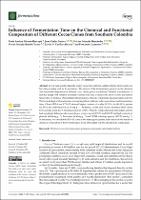Influence of Fermentation Time on the Chemical and Functional Composition of Different Cocoa Clones from Southern Colombia
Fecha de publicación
16-11-2023Autor
Polanía-Hincapié, Paola Andrea
Suárez, Juan Carlos
Hernández, Héctor Eduardo
Ramón-Triana, Vivian Yorlady
Cuéllar-Álvarez, Liceth N
Casanoves, Fernando
Objetivos de desarrollo sostenible
ODS 15 - Vida de ecosistemas terrestres
Tipo
Artículo
Metadatos
Mostrar el registro completo del ítemResumen
Cocoa bean quality depends mainly on genetic material, edaphoclimatic factors and post-harvest processes such as fermentation. The impact of the fermentation process on the chemical and functional composition of different cocoa clones grown in southern Colombia was analyzed. A factorial design with repeated measures over time was used to analyze the effect of clone and fermentation time on chemical characteristics (bromatology, phenolic compounds and antioxidant activity). The bromatological characteristics showed significant differences between clones and fermentation time. Clones EET-8 and CCN-51 showed higher contents of acidity (0.51%), fat (63.61%), protein (12.85%) and carbohydrates (1.63 mg g−1). Moisture, acidity and sucrose increased their values between day 4 and day 6 of fermentation (p < 0.05). Phenolic compounds and antioxidant activity had significant differences between clones, where clones CCN-51 and ICS-95 had high contents of phenols (64.56 mg g−1), flavonoids (3.30 mg g−1) and DPPH reducing capacity (325.55 µmol g−1). In this sense, we consider the FSV-41 clone as the major grain quality index based on the results of chemical composition at the bromatological level, antioxidant activity and phenolic compounds.
Palabras clave
Representación
Sede Central
ORCID-ID
https://orcid.org/ 0000-0001-5928-1837
https://orcid.org/ 0000-0003-1408-456X
https://orcid.org/ 0000-0001-8765-9382
Editor
MDPI
Es parte de
Fermentation
Status
openAccess
URI enlace
https://doi.org/10.3390/fermentation9110982


